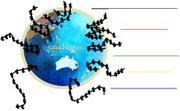History Facts and Words of Australia (february)
- The Bunyip -
The bunyip ("devil" or "spirit") is a mythical creature from Australian Aboriginal mythology.
Descriptions of bunyips vary wildly. Common features in Aboriginal drawings include a horse-like tail, flippers, and walrus-like tusks. According to legend, they are said to lurk in swamps, billabongs, creeks, riverbeds, and waterholes. At night their blood-curdling cries can be heard as they devour any animal that ventures near their abodes.

During the early settlement of Australia, the notion that the bunyip was an actual unknown animal that awaited discovery became common. Early European settlers, unfamiliar with the sights and sounds of the island continent's peculiar fauna, regarded the bunyip as one more strange Australian animal, and sometimes attributed unfamiliar calls or cries to it. At one point, the discovery of a strange skull in an isolated area associated with these 'bunyip calls' seemed to provide physical evidence of the bunyip's existence.
In 1846 a peculiar skull was taken from the banks of Murrumbidgee River in New South Wales. In the first flush of excitement, several experts concluded that it was the skull of something unknown to science. In 1847 the so-called bunyip skull was put on exhibition in the Australian Museum (Sydney) for two days. Visitors flocked to see it and the Sydney Morning Herald said that it prompted many people to speak out about their 'bunyip sightings‘. "Almost everyone became immediately aware that he had heard 'strange sounds' from the lagoons at night, or had seen 'something black' in the water." It was eventually concluded that it was a 'freak of nature' and not a new species. The 'bunyip skull' disappeared from the museum soon afterwards, and its present location is unknown.
As European exploration of Australia proceeded, the bunyip increasingly began to be regarded as not existing. The mysterious skull was later identified as that of a disfigured horse or calf. The idiom 'why search for the bunyip?' emerged from repeated attempts by Australian adventurers to capture or sight the bunyip, the phrase indicating that a proposed course of action is fruitless or impossible.
Although no documented physical evidence of bunyips has been found, it has been suggested by cryptozoologists that tales of bunyips could be Aboriginal memories of the diprotodon, or other extinct Australian megafauna which became extinct some 50,000 years ago. The cries of the possum or koala could likely be mistaken for the bunyip, as most people are surprised to find koalas or possums are capable of such loud roars. The Barking Owl, a nocturnal bird that lives around swamps and billabongs in the Australian bush is sometimes credited for making the sounds of the bunyip. The bird is known to make a call that can easily be mistaken for the cries of a woman or child. Other species of birds, such as bitterns and bush-stone curlews emit blood curdling sounds that were sometimes attributed to bunyips.
The most likely explanation for the existence of Bunyips relates to their locations on the Murray-Darling river system. Australian Fur Seals are known to swim up the river system during times of flood, subsequently becoming trapped within the river system once the flooding resides. There have been dozens of Fur Seals killed or captured as far north as Canberra, incidently, in close proximity to areas where a Bunyip has been heard or sighted.
The coincidence of the features and sounds made of both animals, would necessarily lead to an inland dwelling Aborigine or European to come to the conclusion that the creature was in fact a new species. Meanwhile, those having travelled more widely, would immediately recognise the same creature as a Fur Seal.






Aucun commentaire:
Enregistrer un commentaire